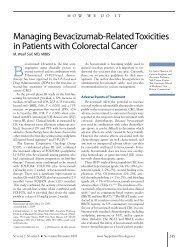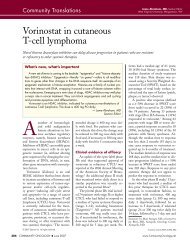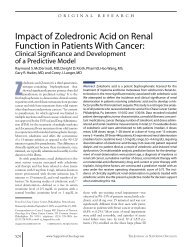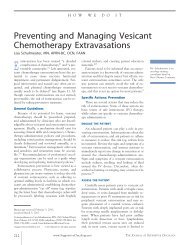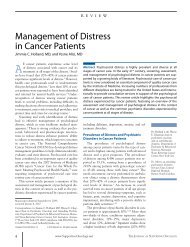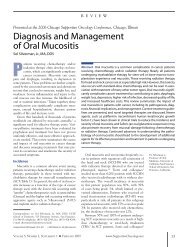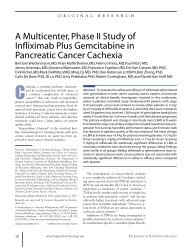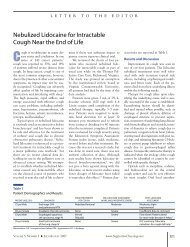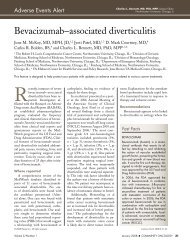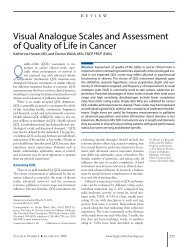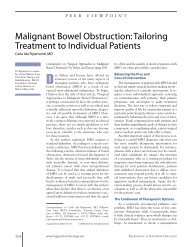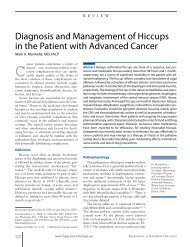Volume 9 Number 3 March 2012 - Oncology Practice Digital Network
Volume 9 Number 3 March 2012 - Oncology Practice Digital Network
Volume 9 Number 3 March 2012 - Oncology Practice Digital Network
Create successful ePaper yourself
Turn your PDF publications into a flip-book with our unique Google optimized e-Paper software.
Features<br />
Fellows’ Corner<br />
How I treat . . . ASH<br />
David Askin, DO, and Jerry George, DO<br />
Department of Hematology and <strong>Oncology</strong>, Lenox Hill Hospital, New York, NY<br />
We’ve attended numerous conferences<br />
during our medical careers, but none<br />
has compared with our experience as<br />
first-time attendees at the annual meeting of the<br />
American Society of Hematology meeting in San<br />
Diego. The meeting was huge, drawing more than<br />
20,000 scientists, clinicians, students, researchers,<br />
and members of industry, from all over the world,<br />
and choc-full of choices when it came to deciding<br />
what to attend. It could have been a logistical<br />
nightmare, but it was meticulously organized,<br />
and from the registration process to the postconference<br />
shipping of our DVDs, it could not<br />
have gone more smoothly. We learnt a few<br />
other things about preparing for and navigating<br />
the conference, and we thought we’d share those<br />
lessons as they could be applied to other conferences<br />
as well.<br />
Two words sum up lesson 1: early bird. And we<br />
mean really early. We registered 4 months ahead of<br />
ASH and were already too late to get into any of the<br />
recommended hotels. We had to settle for a hotel<br />
about 10 miles from the convention center. Registration<br />
for the conference and accommodation can<br />
be done easily online and once that is behind you, it<br />
means you have online access to conference information<br />
and can start preparing ahead of time. Also<br />
be mindful to register early for the satellite symposia<br />
and industry-sponsored CME-certified meetings<br />
(lesson 2), which at ASH were held a day ahead of<br />
the official opening. Those sessions are not included<br />
in the basic registration and you don’t want to be<br />
wasting time at the conference standing in line to<br />
register and risk missing part of the presentation.<br />
Talking of preparing ahead, ASH had<br />
launched a mobile app that included the schedule,<br />
conference information, and updates. It was<br />
extremely useful and user-friendly—there was<br />
Correspondence to: David Askin, DO, Lenox Hill Hospital,<br />
Department of Hematology and <strong>Oncology</strong>, 4 Achellis, New<br />
York, NY 10075;e-mail: davidaskin@aol.com.<br />
Disclosures: Dr. Askin and Dr. George have no disclosures to<br />
make.<br />
no need to lug around books or the bulky paper<br />
schedule and it allowed one to prepare and<br />
schedule sessions well ahead of the conference<br />
(lessons 3 and 4: get the app and plan ahead).<br />
Careful planning is key for a conference this<br />
size. We suggest that you review the reading<br />
materials that you receive after (early) registration<br />
and draw up a schedule before you arrive at<br />
the conference.<br />
Here are a few additional tips for the novice<br />
conference attendee. Dress business-casual—be<br />
comfortable but don’t wear jeans, T-shirts, or<br />
sneakers. Save money by bringing your own refreshments;<br />
our only criticism of the conference is<br />
that meals and refreshment costs were so inflated.<br />
And at the risk of sounding like parents, enjoy<br />
your evenings but don’t stay up late—sessions begin<br />
early, usually around 7am.<br />
None of this is intended to diminish the range<br />
and substance of the superb line-up of presentations<br />
and at the meeting. As clinicians, we opted to focus<br />
on the educational sessions, although we also managed<br />
to attend parts of some of the other sessions. (It<br />
helped tremendously that many sessions were featured<br />
at an alternative time to minimize clashes with<br />
other presentations.) The educational sessions offered<br />
reviews and expert guidance in the management<br />
of specific diseases and updates in advances<br />
and developments in the field. The speakers were<br />
clearly leaders in their fields, and we recognized<br />
many of the names from our readings. Our top<br />
choices from the educational sessions include a<br />
presentation and question-and-answer session by<br />
Theodore E. Warkentin, MD, on the diagnosis<br />
and management of heparin-induced thrombocytopenia,<br />
and a comparison of commonly used chemotherapy<br />
regimes by Ranjana Advani, MD, who<br />
discussed the role of radiation therapy for patients<br />
with Hodgkin lymphoma.<br />
Commun Oncol <strong>2012</strong>;9:112 © <strong>2012</strong> Elsevier Inc. All rights reserved.<br />
doi:10.1016/j.cmonc.<strong>2012</strong>.02.006<br />
112 COMMUNITY ONCOLOGY <strong>March</strong> <strong>2012</strong> www.Community<strong>Oncology</strong>.net



